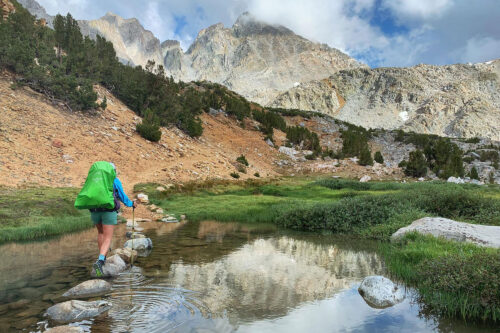John Muir Trail – Hiking

Intro
The John Muir Trail (JMT) is an American classic—211 miles that wind through some of the West’s (and the country’s) most beautiful mountain terrain—sequoia forests and granite mountaintops and deep canyons. The trail’s namesake, John Muir, is well-respected for founding the Sierra Club and for his involvement in shaping Yosemite National Park in the late 1800s. The trail follows along the Pacific Crest Trail (PCT) for 160 miles, connecting its northernmost point at the Happy Isles trailhead in Yosemite Valley to the highest peak in the continental United States at its southernmost point—Mount Whitney—whose summit rises to 14,505 feet. While seasoned hikers often take three or so weeks to hike the trail, some do it in less time, and others, more. Either way, take your time to enjoy the scenery—at your pace. There’s no other trail like the JMT in the world.
What Makes It Great
At just over 200 miles long, the John Muir Trail courses through some of North America’s most beautiful terrain. You’ll hike through Yosemite Valley and past its steep granite canyons, through Sequoia National Forest and beneath some of the tallest trees in the world, through the crevices and valleys of Kings Canyon National Park and the Sierra Nevada, and into the Ansel Adams Wilderness. The John Muir Trail is a legitimate through-hike, giving an abbreviated journey along some of the PCT without compromising the vastness of scenery the Sierra and Northern California are famous for.
There are couple ways to access the JMT near Bishop. The first option is to drive about an hour and 20 minutes south from Bishop to connect with the trail at its endpoint at Mt. Whitney. This is obviously the best option if you are thru-hiking from end to end as well.
If you just want to sample the JMT trail, or take a shorter backpacking excursion, the best place to hit the trail is via the Bishop Creek Trail. Starting at South Lake and heading up the Bishop Creek Trail, you’ll climb almost five miles just to get to the JMT/PCT Trail. But along the way, you’ll pass by several scenic lakes with mountain landscapes in the distance. Once you get to the JMT, go as far as you would like in either direction, then turn around and go back the way you came. There is no permit required for a day trip.
If you plan to have supplies delivered along your route, plan for deliveries near LeConte Canyon/Bishop Pass or Kearsarge Pass. Wilderness permits are required before beginning your trek. Many ask whether they should hike from north to south, or south to north. Both routes are common, and are entirely up to the preference of the hiker(s). If you hike north to south, you’ll summit Mount Whitney with a heavier pack at the beginning of your hike; whereas a southbound JMT hike eases into the higher, more technical sections of the trail, making this the more popular route. Black bears are common along the trail and it’s required to properly store food. Please be mindful of wilderness as bears that come in contact with humans are often euthanized. Pack in bear spray, and have it on hand at all times.
Supported Hiking Trips
Questions about supported hiking trips? These packers are professionals at getting food and gear into the high country and make these multi-day hiking trips way more fun.
WILDERNESS PERMITS: All wilderness permits for guests who hire a packer for a supported hiking trip, aka dunnage and cache (pack it in/pack it out) are provided through the Pack Station commercial quota allocation. These wilderness permits are not issued from the general public quota. If you are riding or hiking with a pack station, the permit will be issued from their commercial quota.
Who is Going to Love It
The JMT is a great destination for many folks, including those who’ve done a through-hike and those who are just beginning longer backpacking excursions. It’s nowhere near as long as the PCT or the Appalachian Trail, but it has no shortage of scenery. Because it’s just 211 miles long, it’s a through-hike that can be achieved in a shorter amount of time—anywhere from two weeks to more than a month, depending on your endurance and timeframe. Some take on the JMT as training for a longer through-hike, while others take on the JMT as a reminder of a completed feat. To many, the JMT is their ultimate goal.
Directions, Parking, & Regulations
Generally speaking, the trail is open from July through September. It’s vital that hikers plan their course with weather in mind, and follow the forecasts before embarking on their adventure.
Weather can change quickly in the Sierra and it’s necessary to be prepared and have a course of action in case inclimate weather interrupts your journey.
Food caching is illegal along the John Muir Trail.
Featured image provided by Peretz Partensky
Written by:
Roots Rated
What is RootsRated? RootsRated is a media platform that connects users with the best outdoor experiences, hand-picked by local outdoor retailers and their networks of local experts. We are NOT another website full of crowd-sourced trail reviews. We harness the collective expertise of high-level local runners, skiers, riders, paddlers, and climbers. Then we share it through exclusive stories and destination reviews—curated city by city—about the best trails, runs, routes, crags, and more. RootsRated brings people who love the outdoors together, through insights from locals who are most in the know.




